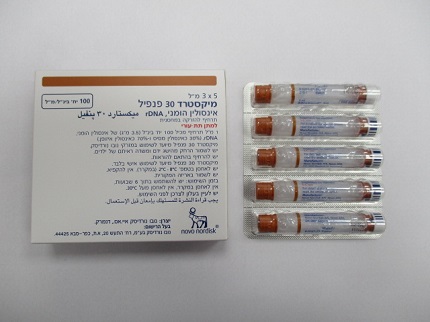Quest for the right Drug

מיקסטרד 30 פנפיל MIXTARD 30 PENFILL (INSULIN (HUMAN))
תרופה במרשם
תרופה בסל
נרקוטיקה
ציטוטוקסיקה
צורת מתן:
תת-עורי : S.C
צורת מינון:
תרחיף להזרקה : SUSPENSION FOR INJECTION
עלון לרופא
מינוניםPosology התוויות
Indications תופעות לוואי
Adverse reactions התוויות נגד
Contraindications אינטראקציות
Interactions מינון יתר
Overdose הריון/הנקה
Pregnancy & Lactation אוכלוסיות מיוחדות
Special populations תכונות פרמקולוגיות
Pharmacological properties מידע רוקחי
Pharmaceutical particulars אזהרת שימוש
Special Warning עלון לרופא
Physicians Leaflet
Special Warning : אזהרת שימוש
4.4 Special warnings and precautions for use Before travelling between different time zones, the patient should seek the doctor’s advice since this may mean that the patient has to take the insulin and meals at different times. Hyperglycaemia Inadequate dosing or discontinuation of treatment, especially in type 1 diabetes, may lead to hyperglycaemia and diabetic ketoacidosis. Usually, the first symptoms of hyperglycaemia develop gradually over a period of hours or days. They include thirst, increased frequency of urination, nausea, vomiting, drowsiness, flushed dry skin, dry mouth, loss of appetite as well as acetone odour of breath. In type 1 diabetes, untreated hyperglycaemic events eventually lead to diabetic ketoacidosis, which is potentially lethal. Hypoglycaemia Omission of a meal or unplanned strenuous physical exercise may lead to hypoglycaemia. Hypoglycaemia may occur if the insulin dose is too high in relation to the insulin requirement. In case of hypoglycaemia or if hypoglycaemia is suspected, Mixtard must not be injected. After stabilisation of the patient’s blood glucose, adjustment of the dose should be considered (see sections 4.8 and 4.9). Patients whose blood glucose control is greatly improved, e.g. by intensified insulin therapy, may experience a change in their usual warning symptoms of hypoglycaemia and should be advised accordingly. Usual warning symptoms may disappear in patients with longstanding diabetes. Concomitant illness, especially infections and feverish conditions, usually increases the patient’s insulin requirement. Concomitant diseases in the kidney, liver or affecting the adrenal, pituitary or thyroid gland can require changes in the insulin dose. When patients are transferred between different types of insulin medicinal products, the early warning symptoms of hypoglycaemia may change or become less pronounced than those experienced with their previous insulin. Transfer from other insulin medicinal products Transferring a patient to another type or brand of insulin should be done under strict medical supervision. Changes in strength, brand (manufacturer), type, origin (animal insulin, human insulin or insulin analogue) and/or method of manufacture (recombinant DNA versus animal source insulin) may result in a need for a change in dose. Patients transferred to Mixtard from another type of insulin may require an increased number of daily injections or a change in dose from that used with their usual insulin medicinal products. If an adjustment is needed, it may occur with the first dose or during the first few weeks or months. Injection site reactions As with any insulin therapy, injection site reactions may occur and include pain, redness, hives, inflammation, bruising, swelling and itching. Continuous rotation of the injection site within a given area reduces the risk of developing these reactions. Reactions usually resolve in a few days to a few weeks. On rare occasions, injection site reactions may require discontinuation of Mixtard. Skin and subcutaneous tissue disorders Patients must be instructed to perform continuous rotation of the injection site to reduce the risk of developing lipodystrophy and cutaneous amyloidosis. There is a potential risk of delayed insulin absorption and worsened glycaemic control following insulin injections at sites with these reactions. A sudden change in the injection site to an unaffected area has been reported to result in hypoglycaemia. Blood glucose monitoring is recommended after the change in the injection site from an affected to an unaffected area, and dose adjustment of antidiabetic medications may be considered. Combination of Mixtard with pioglitazone Cases of cardiac failure have been reported when pioglitazone was used in combination with insulin, especially in patients with risk factors for development of cardiac heart failure. This should be kept in mind if treatment with the combination of pioglitazone and Mixtard is considered. If the combination is used, patients should be observed for signs and symptoms of heart failure, weight gain and oedema. Pioglitazone should be discontinued if any deterioration in cardiac symptoms occurs. Avoidance of accidental mix-ups/medication errors Patients must be instructed to always check the insulin label before each injection to avoid accidental mix-ups between Mixtard 30 and other insulin products.
Effects on Driving
4.7 Effects on ability to drive and use machines The patient’s ability to concentrate and react may be impaired as a result of hypoglycaemia. This may constitute a risk in situations where these abilities are of special importance (e.g. driving a car or operating machinery). Patients should be advised to take precautions to avoid hypoglycaemia while driving. This is particularly important in those who have reduced or absent awareness of the warning signs of hypoglycaemia or have frequent episodes of hypoglycaemia. The advisability of driving should be considered in these circumstances.

שימוש לפי פנקס קופ''ח כללית 1994
לא צוין
תאריך הכללה מקורי בסל
01/01/1995
הגבלות
תרופה שאושרה לשימוש כללי בקופ'ח
מידע נוסף
